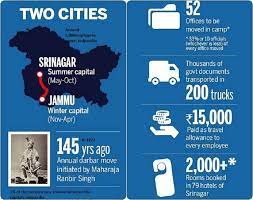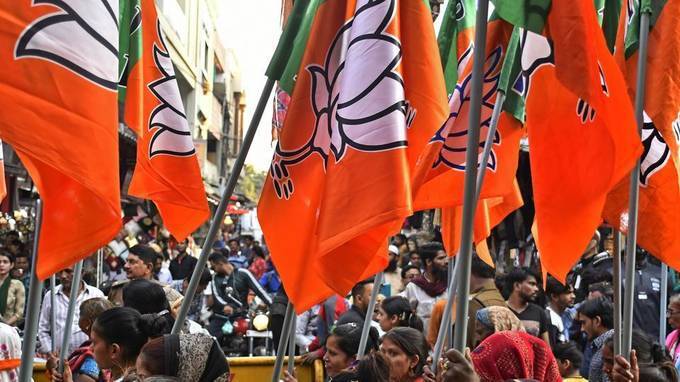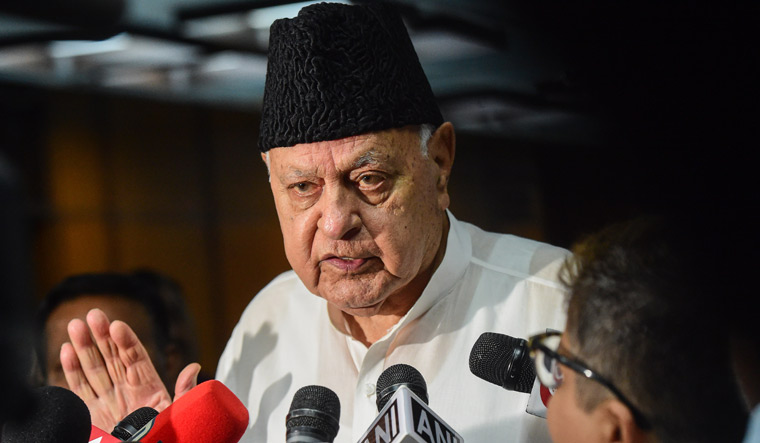The administration had earlier canceled Srinagar and Jammu accommodation for employees moving every six months citing logistical costs.
The November 3 order said, “Sanction is hereby accorded to the partial modification of government order dated 29.06.2021 and restoration of government accommodation at Jammu in favour of all these government employees which were earlier allotted to them.
The J&K administration has restored government accommodation for employees moving from Kashmir to Jammu, on a temporary basis, weeks after cancelling it.
The November 3 order said, “Sanction is hereby accorded to the partial modification of government order dated 29.06.2021 and restoration of government accommodation at Jammu in favour of all these government employees which were earlier allotted to them by the Estates Department on a temporary basis for a period of six months or till the services of the concerned employee is required by the department, whichever is earlier, on payment of rent/license fee as prescribed under rules.”
The administration had earlier cancelled Srinagar and Jammu accommodation for employees moving every six months citing logistical costs.
Darbar Move is…
…the twice-a-year practice of shifting the capital of Jammu & Kashmir from Jammu to Srinagar in the first week of May and from Srinagar to Jammu in the first week of November.
Darbar means ‘[royal] court.’ The monarchy was abolished in 1948. At some stage in the 1960s, ‘Darbar Move’ was officially renamed ‘Secretariat Move.’ However, in everyday conversation the old expression, ‘Darbar Move,’ lingers on.
Does the entire government shuttle between Jammu and Srinagar?
Yes, the entire government shuttles between Jammu and Srinagar…
…but only around 1 percent of the state’s government servants do.
The expression government means the Governor, ministers, Secretaries to the state government, and their staff. They make policies.
The remaining roughly 99 percent of the state’s government servants work in field offices and implement these policies.
Countries with two or more capitals
At present
In 2017, fourteen countries had two capitals (Benin, Bolivia, Chile, Côte d’Ivoire, Georgia, Honduras, Malaysia, Montenegro, Netherlands, Sri Lanka, Swaziland, Tanzania, Western Sahara (SADR), Yemen). South Africa had three.
Many countries house their legislature in one capital, and the judiciary and executive in another (Benin, Bolivia, Chile, Georgia, Malaysia). In some countries, one is the royal capital, and the other is the seat of government (Montenegro, the Netherlands). Of South Africa’s three capitals, one each houses the legislature, judiciary, and executive. In some countries, the second capital in 2017 was only temporary (Western Sahara (SADR); Yemen).
Germany houses the higher judiciary Karlsruhe, the political capital in Berlin, and some ministries in Bonn.
Many countries (Georgia, South Africa) have more than one capital in order to give the people of the various regions of the country the feeling that the capital is in their part of the country as well. In other words, to provide a balance of power between the regions. The European Union has three administrative centers for the same reason.
In the past
From 1951–1969, Libya had two capitals (Tripoli and Benghazi), simultaneously. From 2003–2006, Serbia and Montenegro kept the administration and legislature in Belgrade and the judiciary in Podgorica apparently for a similar balance.
Seasonal capitals in other countries, states, and J&K
Shangdu (Xanadu) was the “Upper Capital” of China during Kublai Khan’s reign (the 1200s).
In Afghanistan, from 1776–1818, Kabul was the summer capital and the warmer Peshawar the winter capital.
The British Government in India followed suit. Its winter capital was in Calcutta (1858–1911) and then Delhi (1911–1947). However, in 1864, Simla was declared the summer capital of British India.
During the colonial era, the French government in Vietnam would shift to Dalat, and the Dutch in Indonesia to the cooler Bogor.
In the summer the Saudi royal family still shifts to Taif, a city in the hills, because it is cooler than Riyadh.
San Sebastián, which is cooler than Madrid in summer, has at times been the summer capital of Spain.
From 1901-1976, Baguio was the summer capital of the Philippines.
The Indian practice
J&K: 2nd century A.D.
The practice of shifting capitals according to the season dates back to at least the 2nd century A.D. when King Abhmanyu I ruled over Kashmir and parts of Jammu. His court would shift to Darvabhisara in winter. Present-day Rajouri, in Jammu, was part of Darvabhisara. The region is somewhat warmer than Kashmir in winter.
British Raj in undivided India: the 1800s
Darjeeling became the summer capital of the British-run Bengal Presidency in 1864. Calcutta was the winter capital.
Murree was the summer capital of British-run Punjab until 1876 when the summer capital of Punjab shifted to Simla. Lahore was the winter capital.
By the late 1800s, even the princely states of India had adopted the bureaucratic- style of government that had been instituted in ‘British India.’ Many British-ruled, as well as princely states, started shifting their Secretariats to cooler parts of their states.
Pachmarhi served as the summer capital for the British-ruled Central Provinces (now Madhya Pradesh, Chhattisgarh, and parts of Maharashtra.) The main, winter capital was Nagpur.
Nagpur is now the winter capital of Maharashtra to the extent that the winter session of the state legislature and the state legislative council takes place in Nagpur.
Because of its pleasant climate, Ranchi was once the summer capital of the undivided State of Bihar-Jharkhand.
The idea in all these cases was to move to a more pleasant climate.
The Ladakh wazarat (district) of Jammu & Kashmir had three tehsils (sub-districts), named after the cities of their headquarters: Leh, Skardu and Kargil. Since perhaps the mid-1800s the district headquarters would shift between the three locations each year. All three are very cold regions. Therefore, the climate was not the issue. Here the idea was only partly to balance the aspirations of the people of the three very vast and distant regions. More importantly, before the advent of mechanised transport, it would take petitioners from one tehsil several days on foot to reach the other tehsil. The road between Leh and Kargil and the Kargil-Skardu road has generally been all-weather roads but it would take several days on foot to travel between these towns. So the government felt that the considerate thing to do was to let the senior officers shift their offices (and residences) between the three tehsils instead. And they, being government servants, did it on ponies, which the government paid for, rather than on foot.
In Jammu and Kashmir
The Valley of Kashmir (as well as Ladakh and Baltistan) became part of the Jammu kingdom in 1846. Therefore, for the first 26 years, they were administered from Jammu city, which was the capital of the Jammu kingdom. The Maharaja of Jammu and Kashmir considered this inconvenient to the people of Kashmir province.
Since October 1947, the Valley of Kashmir has been more populous than Jammu province.
However, in 1872 when the Darbar Move first started, Jammu province was bigger than Kashmir province in terms of population as well as the area (and remained so till late 1947).
The last census conducted before the partition of India (and the subsequent occupation of parts of the state by Pakistan and China) was in 1941.
Jammu province had a population of 20,01,557 and an area of 32,200 sq. km.
Kashmir province, not including Ladakh, had a population of 17,28,686 and an area of 22,200 sq. km.
Jammu can be quite warm in summer and Kashmir quite cold in winter. British bureaucrats in Bengal, the Punjab, Central Provinces, and Delhi had no roots in any Indian city. They probably looked forward to shifting for a few months to the capital with the more pleasant climate.
Not so in Jammu or Kashmir. Jammu bureaucrats found it as irksome—and disruptive of their children’s education—to shift to Srinagar, as Kashmiri bureaucrats found shifting to Jammu. Each was settled comfortably in his own home and used to the two or three months of unpleasant weather. It remains so to this day. the senior-most officers, because of better perquisites, do not dread the Move as much as middle- and junior- ranking officers do.
The Move crippled the lives of IAS, IPS, and IFS (forest) officers from outside the state the most because they had to pack every doormat, pin, and dustbin that they owned and shuttle it between the two capitals. They had to shift even such clothes and heating/ cooling equipment as were not required in the other capital. (Local officers, on the other hand, moved only essential items to the other capital and left the bulk of their worldly belongings at their permanent home in Jammu or Srinagar.)
In 1990 officers who did not have houses in Srinagar were shifted to Srinagar without their families and housed in hotels there, because of the law and order situation. Their families were allowed to stay in the government houses allotted to them in Jammu.
This practice continues to this day, and officers from outside the state need not throw away old magazines and fancy gift wrapping that they hope to reuse someday. Nor do they have to move their heavy air conditioners to the naturally-cool Srinagar.
However, back in 1872 Maharaja Ranbir Singh felt that in the interest of equity his officers and he should spend exactly six months each in Jammu and Srinagar. The intention was the same as in Ladakh wazarat—equitable attention to the people of the various regions.
Shifting home between cool Kashmir and relatively warm Jammu is ingrained in the culture of Jammu & Kashmir. For centuries nomadic Gujjar cowherds and Bakerwal shepherds (both are Muslim communities) have been moving their entire flock as well as household between the mountains of Kashmir/ undivided Doda district and the plains of Jammu/ Punjab (Dina Nagar), spending almost exactly the equal time in their summer and winter homes. Gaddi (Hindu) shepherds and some Ladakhi (Buddhist) livestock- owners tend to shift less comprehensively to their summer camp in the mountains, but the principle remains the same. The principle is NOT to get away from the heat or cold but to shift to a place that was likely to have grass for their cattle and sheep. Kashmir, the upper reaches of the undivided Doda district, and the upper reaches of Ladakh get covered with snow in winter, so the flock is moved to places where the grass is available.
The Gujjar- Bakerwal practice would certainly have been in the Maharaja’s mind when he invented the Darbar Move for Jammu & Kashmir in 1872.
The mechanics of shifting
On the third, sometimes fourth, Friday of every April, the Jammu and Kashmir government shuts down for five working days (but nine days in all). It reopens in Srinagar on the first Monday of May.
Similarly, on the third or fourth Friday of every October, the state government shuts down for five working days and reopens in Jammu on the first Monday of November. To the extent possible it is ensured that bureaucrats are in Jammu for Diwali.
Dr. Abdullah’s failed attempt to end the practice, Why Darbar Move could not be discontinued
Our rulers have a ritualistic denunciation of this practice [which began in 1872]. The political ritual developed in 1987 when Farooq Abdullah, after staging a comeback to the Chief Minister’s chair to head NC -INC coalition Government – pursuant to his accord with the then PM Rajiv Gandhi – made a declaration that he would dispense with the tradition of bi-annual Darbar move Rajiv Gandhi lent him full support Both went on to describe the practice a ” retrograde move ” which caused an unjustifiable drain on the state exchequer ‘. Now [in 2017] we have Speaker of the Assembly wanting to abandon the practice, on similar grounds. BJP has endorsed his statement J&K Panthers Party and Dogra Saddar Sabha, Jammu are vociferously campaigning for scrapping the Darbar shift Before it snowballs into another controversy and issue is made of it, the matter must be put in proper perspective
It needs to be recalled that Farooq Abdullah’s attempt to do away with the bi-annual Darbar move was fought tooth and nail by the people in the Jammu region A peaceful agitation, against the declaration, was launched here under the leadership of Bar Association, Jammu. The month-long agitation in the autumn of 1987, finally saw the C M backing out of his announcement. Barring the ritualistic noise, thereafter, it has been a happy life for the annual Darbar move
In 1987, we had an occasion to make a comment on the declaration of Farooq Abdullah It is time to make a recollection of that. No doubt the Darbar shifting exercise involves expenditure. In 1987, it was calculated at Rs 3.5 crore. Today it may be ten times more but the benefits in terms of social cohesion, emotional integration and political unity, the shifting of [civil] secretariat brings in, far outweigh the monetary considerations involved in the process
It is no denying that there is little common between the people living in two provinces of the state-by way of geography, history social fabric, and cultural activity. Yet they have been living harmoniously like one political entity. The practice of the bi-annual Darbar move ‘has with a great degree of success cemented the diametrically opposed social and cultural relations between the different peoples, living in the Valley and Jammu region. The exercise besides being a movement of the Capital constitutes a measure aimed at the emotional integration of two different ethnic groups. In fact it provides a raison d’être for nomenclature of the State (J&K).
The Darbar move not only brings capital near to the people of each region but also helps them to hear each other’s heartthrob. Surely, there can be no better mode of uniting people than the one of bi-annual shifting of the Darbar For the territorial and political integration of Jammu and Kashmir the practice of bi-annual Darbar move has, indeed, proved a boon. We owe it to our far-sighted rulers from the Dogra land
The stoppage of Darbar’s move will put to a halt the process of coming together of people of different regions of the State. Today, when in India need of the hour is to transcend geographical and cultural barriers doing away with the shifting process will mean an inculpable loss to the composite character. It will result in compartmentalization that shall be incompatible with the national and emotional integration of the people. For those who want disintegration of J&K, the stoppage of the bi-annual practice would come as a Godsend opportunity. In Kashmir some people are complaining of an imaginary cultural onslaught and, therefore, want minimum interaction with the mainland this comes close to their campaign to erase all signs of composite culture and paint, leftover, in a sectarian color. Scrapping of the Secretariat shift will surely embolden them to proceed vigorously with the unholy design
One gift, among so many, the Dogra Rulers gave to the people of J&K has been the incarnation of bi-annual Darbar move tradition The exercise has, thus far, proved a singular instrument that has imperceptibly and without any clatter cut across the regional and psychological barriers and gave people a sense of oneness It is our duty to uphold the tradition.
For the patriotic people of Jammu, it is time to recall the autumn 1987 spirit and rekindle the nationalistic fervor Instead of being unwitting facilitators, we must be a bulwark against the fissiparous elements working overtime in State, more particularly in the Valley Party politics can wait.






